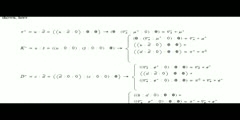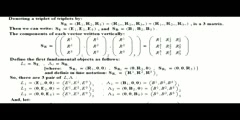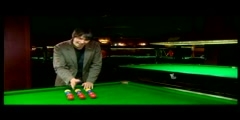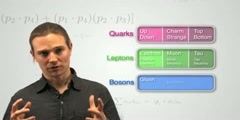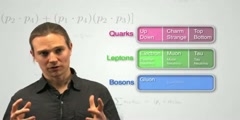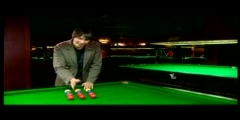Hadron Architecture and Meson Decays 1
Hadron Architecture and Meson Decays 1 © 2011 Claude Michael Cassano A hadron is usually defined simply as a composite particle made up of quarks held together by the strong force (as atoms and molecules are held together by the electromagnetic force); categorized into two families: baryons (made of three quarks) and mesons (made of one quark and one antiquark). A Breit-Wigner cross-section resonance is a characteristic of a particle, such as an electron, a baryon, or a meson. Although quarks always occur bundled, their non-observation is also attributed to the fact that the resonances of the bundles is as a singleton - rather than a cluster of distinct individual resonances. This leads to only one conclusion. Hadrons are S sub R matrices, not fully decomposed into singletons, as leptons are; and this resonance is a characteristic of individual S sub R matrices. What satisfies the Dirac equation also satisfies the Klein-Gordon equation. The Dirac equation illuminates a characteristic of particles called spin. This is manifested in the S_{R} matrix structure with each column-object singleton (fermion) possessing a half-integral spin (up/down, or ±1/2). Spin computation is about as simple as addition. When two half-integral spin particles form a hadron, the hadron spin is integral . When three form a hadron, the hadron spin is half-integral . Hadrons may be best understood as 3×3×3 S sub R matrices. That is, as the 2-dimensional 3×3 S sub R matrices extended into an additional depth dimension (of the same set as the others)(recall the reason from [1]) (picture as a Rubik's-cube, rather than a square). Examples of this nature have already been noticed in [1], during certain interactions. On S sub R matrix fusion, components of the same column/generation fill higher depth dimensional slots in the matrix, if necessary (as seen in some examples in [1], when more than one column-object singleton of the same column/generation fuse filling the same column/generation slot are actually filling the same column/generation slot in the next depth dimensional object entries,of the 3×3×3 S sub R matrix). A Z amount of energy may push a depth-1 column-object into a depth-2 column-object, and also vice-versa; and the same quanta necessary to change a column-object between depth-2 and depth-3, and directly between depth-1 and depth-3. This indicates as well, that a W amount of energy may change an object's row/color (independant of column/generation) into a set of column-object singlets each of which is of differing color. . Thus, an explanation for the energy quantization of weak and strong (W/Z) interactions, because Z type interactions always involve a change of column depth (while in the fusion, the two objects share the same column), while W type interactions involve a change of row/colors. And, now, expounds upon a greater range and specificity of the fermion interaction. Note that since these are quantum values, it is impossible to overcome their action despite indefinite application of energy. Only the interaction energy quantum is applied to the interaction processes. The rest is only manifested in exiting object energy (along with that interaction energy quantum) - because energy must still be conserved. And that energy is distributed such that momentum and angular momentum are conserved, as well. So, the interaction region will express these particle characteristics while it exists as such, the interaction energy quantum being exihibited as rest mass. As described in [1], only fermion pairs enter and exit W/Z interaction regions, which means they exhibit integral spin. Now, as noted above, during interaction the object-fusion manifests with a particle characteristic Breit-Wigner cross-section resonance, rather than a cluster of distinct individual resonances. The same is true of hadrons. Using the above 3×3×3 S sub R matrix structure, the picture of hadrons may be seen, explaining why they manifest a single resonance. Firstly, every S sub R matrix structure manifests itself with a resonance, above and beyond the component objects of which it is comprised. This is demonstrated by the above W/Z interactions dependant only on the depth change/row change quanta. This comes from it's Breit-Wigner cross-section resonance [5] A strong bond exists second order column-object-singlets (flippable entry-wise combination). Recall, from [1], that a flippable entry-wise combination means that entries in the same column of the form R sub m sup alpha : R sub n sup alpha - bar may flip to eta-naught of R sub m sup aalpha : eta-naught of R sub n sup alpha - bar etc. as you see, here, adjusting the terminology of [1] into depth. Recalling, from [1], using the above notation (generation 1 only & neglecting color and the identity interaction), some basic light fermion interactions may be written as here. Interestingly, the rho and pi mesons are made up of the same quark pair (u/d) , but have different rest mass and decay modes, as here. Similarly, the Δ-plus/Δ-naught and nucleons proton/neutron are made up of the same quarks (uud/ddu) ; but have different decay modes and are regarded as having different rest mass, Note that the beta decay shown above illustrates that, although light fermion interactions satisfy: A+B→C+D => C-bar + D-bar → A-bar + B-bar baryons do not; since the proton/anti-proton is stable, while the neutron decays as noted above./nAs always, find links to all my books at the site listed at the bottom, here: /nhttps://sites.google.com/site/themathematicalnatureofreality/config/pagetemplates/books
Channels: Physics (General) Particle physics
Tags: standard model physics electric field magnetic field quark lepton fermion particle physics
Uploaded by: cloudmichael ( Send Message ) on 21-10-2011.
Duration: 18m 10s
